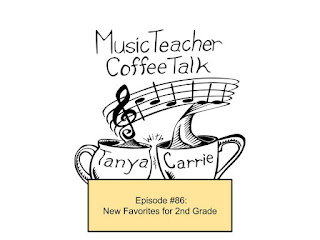Episode #109: Learning Stations in the Music Room
Main Theme: Learning Stations in the Music Room
Why have Learning Stations?
- Great way to practice known concepts
- Allows for small group learning and collaboration
- Provides intervention opportunities
- Fun and engaging!
Who can enjoy Learning Stations and who are in your groups?
- Learning Stations can be adapted for all elementary students from Kindergarten up!
- Students can be grouped randomly, by behavior, by skill.
- Students can have the opportunity to choose their own group.
When should Learning Stations be planned?
- Use Learning Stations when practicing known concepts.
- Learning Stations can be used as a way to intensely practice one particular concept or unit.
- Learning Stations can be used at the end of a grading term to practice multiple concepts learned.
- Learning Stations are a great way to incorporate holidays and seasons. They are also perfect right before a school break!
- Great for sub days and no-voice days!
- Great for extra classes.
Where should Learning Stations be placed in the classroom to maximize learning?
- Think of your space and sound constraints.
- No more than 2 noisy stations and be sure to spread those out in the room.
- Keep stations and transition directions fairly consistent.
- Place markers and short directions at each station.
- How many stations? Depends on your class time and size. For a 45-minute lesson, we recommend 4-5.
- If you have large classes, you can double your stations by having two sets of the materials at each station.
- If you have short passing periods between classes, consider having the same stations for multiple grades, or stations that you can quickly swap out between classes.
Station Ideas: Smartboard/Interactive Whiteboard
- Interactive whiteboard games (check out TPT products from Tanya LeJeune, Aileen Miracle, Amy Abbott, and Linda McPherson
- Explore music with Thinglink clickable activities (see Carrie's example)
- Composition using a digital template
Station Ideas: Music Literacy Games
- Memory games
- Altered board games
- Flashcard games (check out Tanya's set of Rhythm Tent Cards)
- Fiddlesticks
Station Ideas: Instruments
- Play known songs or use manipulatives to compose and play
- Boomwhackers
- Recorders
- Ukulele
- Orff Instruments
- Non-pitched percussion
- Keyboards
Station Ideas: Music Writing and Composition
- Rhythmic dictation with wooden blocks, popsicle sticks, rhythm cards, white boards
- Melodic dictation with staff and counters, solfa or staff buttons, white boards, floor staff
- Composition with worksheets or manipulatives
- Worksheets
Station Ideas: Singing and Storytelling
- Selected picture books
- Sing and play a favorite singing game
- Act out a story song with puppets
Station Ideas: Technology
- Chromebooks: provide a links page where students can explore or have specific assignments on Google Classroom, Seesaw, Schoology, etc.
- iPads: Garage Band, Staff Wars, Auxy, NoteWorks Lite, Rhythm Cat Lite, Blob Chorus Ear Training, Chrome Music Lab (set up a short-cut)
- Dash Robot with xylophone attachment
- Listening Station
Tips and Tricks for successful Learning Stations
- Use cones or markers so students can easily find stations.
- Post brief student-friendly directions at stations.
- Be sure to front-load stations by doing activities whole group in lessons prior.
- Use special seating (rocking chair, bean bags, stools) and props (pointers, puppets, timers) to engage students in otherwise lackluster activities.
- Use recorded music or play a song on the piano to indicate clean-up and switching time.
- Argumentative groups? Assign roles for each individual (the manipulatives passer-outer, the announcer who reads the instructions out-loud, the time-keeper, the director who keeps track of turn order)
Know Better, Do Better
Carrie talked about the importance of knowing if a singing game is inherent to the song and its origin, or if it's a teacher-created game or activity. That way you can communicate that understanding to your students. You can also separate the song from the game if needed, which is especially helpful if you want to use a teacher-created game that is often played with a problematic song and apply it to a new piece of literature. An example is using the chase game that is commonly played with the song Chicken on a Fencepost and playing it while singing the song Sansa Kroma from Ghana. You can find the notation and origin information for this song in the resource Let Your Voice Be Heard: Songs from Ghana and Zimbabwe by Adzenyah, Maraire, and Tucker.
Work Smarter, Not Harder
Tanya recommends keeping a notepad, blank paper, or electronic resource available when doing organizational tasks (such as cleaning out the office) so you can write down reminders and ideas as you think of them. That way, you can continue with the task at hand without getting derailed or distracted by other tasks.
Coda
Carrie recommends watching the show Life & Beth (on Hulu)
Tanya recommends listening to the Bulgarian State Television Women's Choir
Did you enjoy this episode and/or find it helpful? You can thank us by buying us a coffee! Click the button below!

.jpg)
%20(4).jpg)


Comments
Post a Comment